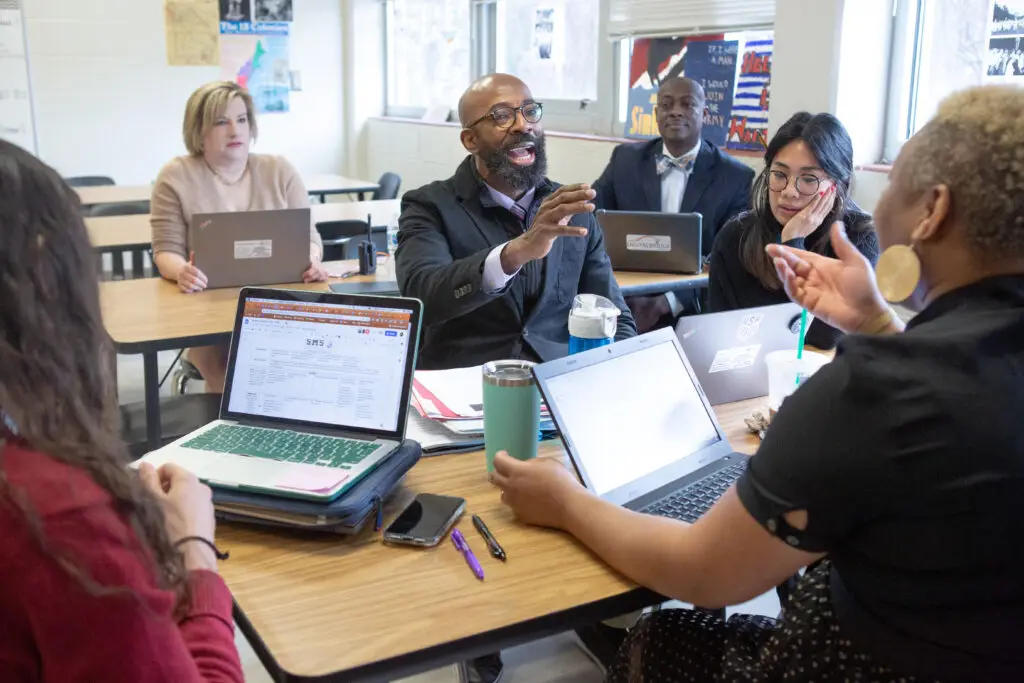Big city districts face a sea of troubles—from persistent pandemic-related learning loss to student and teacher absenteeism, to declining enrollment, to political pressures and fiscal cliffs. Can district leaders keep this turbulence from disrupting schools and focus on instruction?
We raised a similar question over twenty years ago in our report, “An Impossible Job? A View from the Urban Superintendent’s Chair.” A new CRPE study reveals that the question is still open—and, if anything, the mismatch between the challenges district leaders face and their capacity to address them has grown.
In this new study, we examined two districts that epitomize present-day challenges: the Baltimore City Public School System (BCPSS) and Chicago Public Schools (CPS). The results, especially district leaders’ determination to stabilize schools while focusing on instruction, were heartening. The report provides a portrait of dedication and realism, yet it also shows that success is not a sure thing.
Based on extensive interviews, we report that district leaders in Baltimore and Chicago are trying to:
- Reduce gaps in the quality of instruction between schools by standardizing materials, schedules, and teacher training.
- Support teachers and respond to declines in student motivation by adding new staff.
- Mount new initiatives focused on students’ emotional needs by using remaining federal COVID-19 relief funds—and trying not to cut into funding for instruction.
- Respond to rapid turnover of teachers, principals, and central administrators by promoting from within.
- Insulate schools from political turbulence by taking the hits themselves.
BCPPS and CPS leaders are playing the hand they have been dealt, coolly and with determination. But they struggle against real limitations. Declining enrollments are eroding the district funding required to implement the first three strategies above. Rapid staff turnover means that teachers have varying levels of training. Student absenteeism can force teachers to choose between following the curriculum and dealing with what students have missed. Political turbulence and neighborhood crises distract teachers and principals, and even the most capable district leaders are insecure in their jobs.
As our earlier studies have shown, district leaders elsewhere are facing similar challenges, and as we noted 21 years ago, these are persistent problems that leave superintendents feeling like they are set up for failure. For current leaders steering their districts around the hazards they encounter, they would do well to emulate the steadiness and selflessness of leaders in BCPSS and CPS.
However, these leaders will need to search for new options and forge alliances if their districts are “maxed out.” Leaders facing staffing challenges should consider a radical restructuring of the teacher role to make the job more enticing. When declining enrollment makes some schools too small to provide sound programming, leaders must close them rather than drain resources from better-functioning schools. When spending commitments cause massive deficits, leaders must campaign for more money while continuing to function under current limitations.
Local education leaders need to seek help, primarily from their states but also from their city governments, foundations, and local public service agencies. Those entities need to help districts but not encourage them to staff or spend at unsustainable levels.
State governments have the greatest potential of any entity to help overwhelmed school districts. For districts that face problems similar to those in Baltimore and Chicago, states can:
- provide political cover and regulatory relief for strong local leaders by suspending policies or contracts that prevent innovative staffing arrangements, screening teacher recruits for math knowledge, or requiring classroom use of innovative instructional materials.
- maintain the pressure on local school boards and interest groups by keeping the possibility of takeover on the table and by openly considering alternative educational options for students, such as authorizing high-performing public charter schools.
- help districts forge new alliances to adopt new strategies by providing tax incentives and grants for partnerships with employers, social services, and higher education institutions.
Foundations can help by creating incentives for new teachers to work in central city districts and paying for research and development on SEL programs and curricula. Foundation grants could also help schools pay for independent expertise and assistance when central office staff is tapped out. Local nonprofits can work with district leaders to focus on social and instructional support when central offices can’t meet the nonacademic needs of students and families.
And, of course, local school boards can do a much better job buffering schools from disruption and not scapegoating district leaders for problems they can’t possibly solve alone.
As was the case 20 years ago, the challenges facing schools in many big cities exceed the capacities of their districts and leave superintendents feeling like they are set up for failure. The superintendency remains, in many cases, an impossible job—unless district leaders can build coalitions with states and cities, foundations, nonprofits, and social service providers. Strong superintendents are key to system success, but not sufficient unto themselves.





